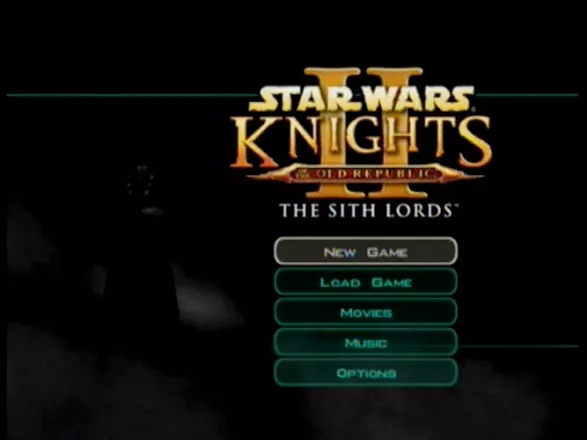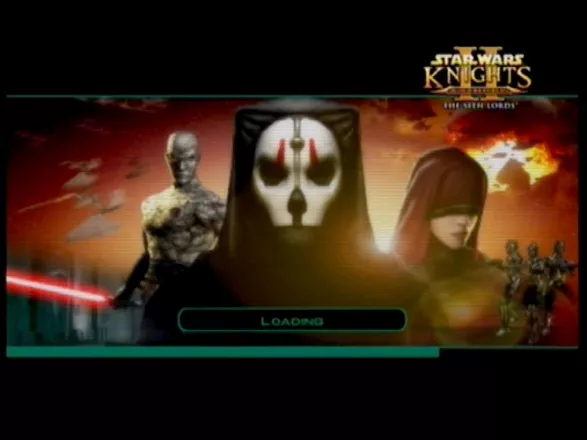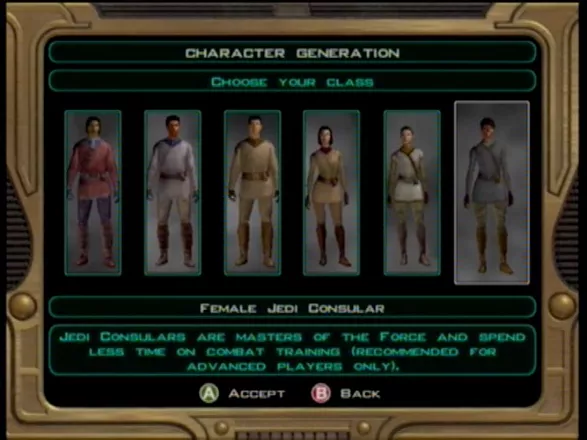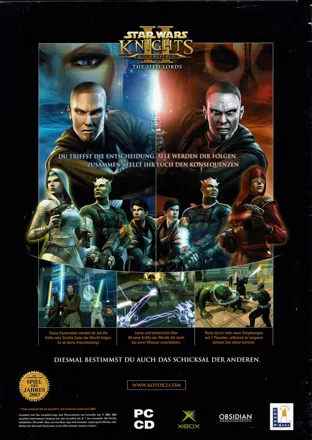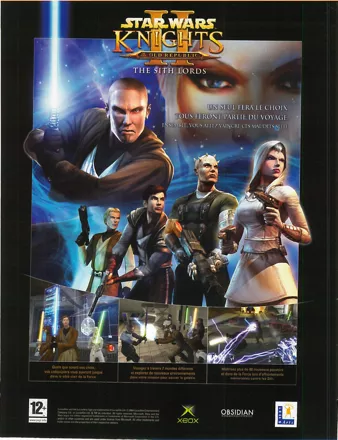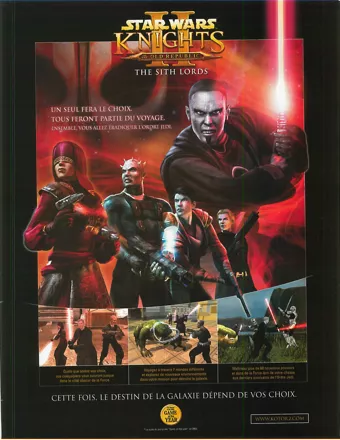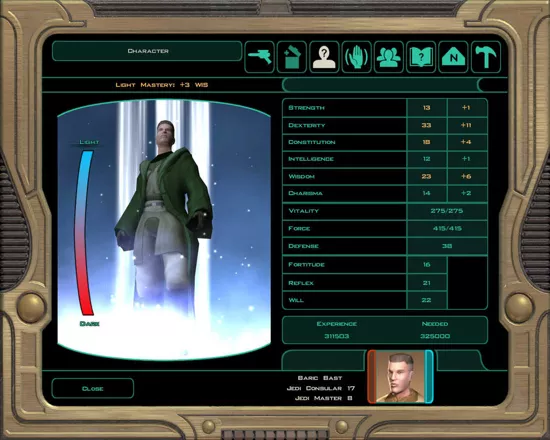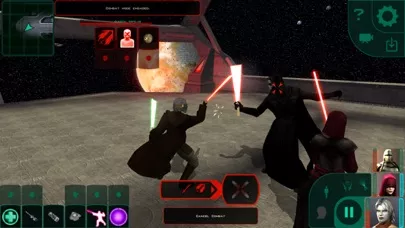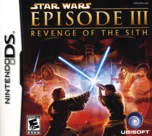Star Wars: Knights of the Old Republic II - The Sith Lords
Description official descriptions
Five years after the events depicted in Knights of the Old Republic, the Sith have become stronger and more determined to rule the Galaxy. The Jedi Order is nearly exterminated. A mysterious ex-Jedi has been exiled from the Order and is traveling alone. This Jedi had served under Darth Revan (when the latter was still on the Light side of the Force) during the Mandalorian Wars, but due to enigmatic circumstances was forced to retire. Now the past is catching up with the Jedi, and soon he or she will have to choose the side to fight on.
The Sith Lords looks and plays very similarly to its predecessor, also being based on the Star Wars d20 role-playing rule set (which, in its turn, is similar to the 3rd Edition of Dungeons & Dragons) and having the same combat engine, character development, and a Light and Dark ethical system, which judges the player's decisions and actions and influences story events and characters' responses. Additions to the gameplay include a lightsaber-crafting system, which allows augmenting lightsabers with various items, new Force powers, and the possibility to influence the alignments of the characters in the player-controlled party through conversation choices and other decisions. Most of the exploration and the combat sequences is done using a party of three, including the protagonist and two companions. However, certain parts of the game will force the player to travel alone, or to control a party made exclusively out of companions.
A large part of the military equipment can be upgraded using any workbench that can be found throughout the game world, including one available at all times on the ship that the player uses to travel between planetary systems. Different types of items have more than one piece that can be augmented. For example, the armor has two slots for upgrades (overlay and underlay), while ranged weapons have three (targeting, firing chamber, and power pack), and lightsabers have six. The easiest way to get additional upgrades is to either buy them or loot them, however they can be created as well at a workbench with the right components and enough repair skill. Medical items are a different sort and they can be crafted using lab stations.
At various moments during the game, the player has the opportunity to play some mini games: a card game called Pazaak, shooting targets using a turret from a first-person view, and swoop racing.
Spellings
- 旧共和国武士II:西斯领主 - Simplified Chinese spelling
Groups +
- 3D Engine: Odyssey
- Console Generation Exclusives: Xbox
- Force Powers-themed games
- Gameplay feature: Character development - Skill distribution
- Gameplay feature: Dating / Romance
- Gameplay feature: Gambling
- Gameplay feature: Multiple endings
- Middleware: FaceFX
- Protagonist: Female (option)
- Sound engine: AIL/Miles Sound System
- Star Wars licensees
- Star Wars: Knights of the Old Republic series
- Star Wars: The Old Republic games
- Symphonic Orchestra: Northwest Sinfonia
- Technology: amBX
- Xbox Platinum Hits releases
Screenshots
Promos
Videos
See any errors or missing info for this game?
You can submit a correction, contribute trivia, add to a game group, add a related site or alternate title.
Credits (Xbox version)
332 People (259 developers, 73 thanks) · View all
| CEO | |
| Executive Producer | |
| Producer | |
| Lead Designer | |
| Design Team | |
| Lead Artist | |
| Art Team | |
| Additional Concept Art | |
| [ full credits ] | |
Reviews
Critics
Average score: 83% (based on 59 ratings)
Players
Average score: 4.0 out of 5 (based on 140 ratings with 10 reviews)
The First one was great, the second one is...WOW!
The Good
The Sith Lords is such an enormous game I'm surprised it doesn't take up all 50,000 MB in the XBox. Still, it's worth every byte. I love the really wide variety of Lightsaber colors (they have a silver crystal. SILVER!). And the fact that they kept the spirit of the previous game and the movies. As soon as I heard "The Jedi" music in the music section of the main menu, I immediately fell in love with it. It's even better the John Williams (sorry fans).
The Bad
It's pretty much the same storyline as the first one accept instead of finding the Star Maps, you find the remaining Jedi Masters. Another blow is not allot of the original characters are in this game. Real disappointment. You only see Carth Onasi on the Dark Side story, Bastila in the tomb on Korriban and at the end of the dark side story, and Darth Revan at the end of the tomb on Korriban.
The Bottom Line
KOTOR II makes it to Number 3 in my top games of all time. Simply nothing else can be said. It is just fantastic. Here's to Knights of the Old Republic 3
Xbox · by M.Allen (83) · 2006
The Good
With a slightly different flavour from the original, Knights of the Old Republic II : The Sith Lords (k2 from now on) keeps just enough continuity with the original to be accessible, enjoyable, and at time extremely compelling. Because it is a sequel, it lacks the features that made KOTOR I a unique and superior to many RPG’s on the market, but while it doesn’t pave any new road, k2 provides an excellent gaming experience, even superior to its predecessor in many ways. This review will be written primarily for those who have not played the first KOTOR game.
As in all RPG’s, the fundamental questions of quality relate to storyline and character quality. Are the quests good? Are the characters memorable? Can I make meaningful alignment-related (e.g. good/evil) choices? Can I customise my character sufficiently to provide a ‘role-playing’ experience? Is the plot interesting? I would argue that in terms of these RPG/plot/character questions, k2 excels.
The plot starts out a bit confusingly, as you wake up on a station (in the age-old gaming plot device) without any recollection of how you got there. The confusing bit for the player, and a weakness of the story, is that somehow the CHARACTER seems to know a bit about his history, but you, the player know absolutely nothing. It’s quite odd to learn about your character by seeing him say ‘I used to be a Jedi.’ There are other hackneyed plot bits throughout, but it’s important to remember that this is an RPG, so the line between ‘hackneyed’ and ‘epic’ can become blurred.
These weaknesses aside, the plot is quite good. You’ll travel with your band of characters throughout the galaxy to different planets. You’ll then be embroiled in numerous minor and major quests that drive the ultimate story line about your main character.
The ‘boss’ bad guy is not revealed until quite late in the game, a la Neverwinter Nights. I’d argue that this is a strength to the game, as it makes the experience more compelling.
The characters throughout the game are fantastic. NPC’s abound, as well as the standard ‘commoner’ characters. ALL of the human conversations are voice-acted, and quite well I’d add. The NPC’s you interact with are usually memorable and lifelike. There are few ‘caricature’ characters in this game. Your character is a sort of anti-hero, another commonality between this and KOTOR I, but there’s a distinct subtlety to his anti-heroism. He has just enough mystery to be intriguing, but not enough to be clearly crafted as the ‘mysterious’ character. I think playing it through with a female character would be even more interesting, as anti-heroes are so rarely female. There is apparently the option to pursue romantic ties between your character and others, but I haven’t gotten around to it yet. Too busy force-choking people.
Additionally, ALL of the party members have distinct personalities, most of which are quite engaging. The meddling Kreia drives me up the wall, I chuckle at HK-47’s commentary, and also enjoy getting to know the somewhat-too-obviously-elusive Atton. It makes for satisfying gameplay to know that there are 8 or so people you can choose to have hang around your character. Like in the original, the party members you choose will interact with one another and you and you can learn more about their respective histories through fighting alongside them, much as you’d expect from real life, were you to be a space-faring adventurer…An additional element to this game that sets it apart from the original is that your main character will have ‘influence’ with each of the other characters. This influence is affected by whether or not you treat them well, agree with them, etc. The more influence you have, the more this character will ‘open’ up to yours in dialogue, and also the more their alignment will switch along with yours.
The quests contain the garden variety fetch quests. But in addition to the bread-and-butter quests you’d see in any RPG, there are a number of interesting minor quests available. Sometimes they involved playing two NPC’s off one another, sometimes there’s a betrayal involved, etc. Overall, the minor quests are good, if not great. Incidentally, a fair number of them involve puzzles which vary in difficulty, which might please the adventure-gamer within some players.
The major quests, which further the story line, are fantastic, and require their own paragraph. There is a great deal of party shuffling in this game (a la Final Fantasy 3 & &) but this is never a pain because all party members earn experience together (see gameplay comments below). Instead, it becomes really exciting to split the party up to see how other characters interact and get a chance to see how strong they’ve all become. I was riveted by all of the times in which your party gets split up. Usually, the cuts between groups are quite frequent and are tied to actual plot cliff-hangers with reasonable levels of importance (e.g. one of your characters appears to be dead). These are actually some of the best moments I’ve had in PC RPG gaming.
All in all, the RPG elements of k2 are fantastic, above and beyond the quality present in the first.
The gameplay is also excellent in its own right, even if it builds on its predecessor. It’s all a complex series of stats and dice rolls, a la D&D 3rd Edition. However, rather than simply having one motion for ‘attack,’ each melee move or blaster shot technique has a number of animations. The effect is that it appears to be real-time fighting even though it’s actually a series of rolls. Clever. One will eventually see all there is to see in the combat system, but this is to be expected and is hardly much of a weakness.
There are feats, skills, attributes, and force powers to contend with for each character. Obviously, non-force users don’t get force powers. The number of feats has been increased since KOTOR I, which I feel is a positive thing. KOTOR I felt like dumbed-down D&D 3rd Ed (no comment) and k2 has done much to increase the complexity of choices available to players. Still, much remains the same. There are two basic paths to combat: ranged and melee, and within each are three feats to use for attacking. There are also 8 or so skills (computer, repair, etc) which are identical to KOTOR I. Suffice it to say that there is a reasonable amount of customisation available, but not as much as in a proper RPG. But this is also expectable. Think of k2 as Neverwinter Nights with training wheels.
Actual in-game control is fluid and intuitive. There is a optional training scene at the beginning of the game to assist in orientation to the control of the game, but many won’t need it.
The Bad
The graphics and sound are beginning to look and sound their age. With the source engine, far cry, doom3, and all manner of other great graphical engines, k2 is dated. Full stop. The sounds are also mostly recycled from a) John Williams’ now 25-year-old score or b) the same as in KOTOR I. The dated quality of the graphics and the samey-ness of the sounds are clear weaknesses to the game. Still, because this is an RPG and not a FPS, I’d argue that they are minor weaknesses.
The Bottom Line
To summarise, KOTOR II is a fantastic game. It is simple compared to other RPG’s out there, but it is also accessible, engaging, and entertaining. It has an excellent plot, memorable characters, and a reasonable amount of room for character customisation. While its graphics and sound are a bit drab, these weaknesses are not significant when compared to the strengths, as this game contains some incredible gaming moments. And hey, who DOESN’T want to be a Jedi for a little while?
Windows · by Marty Bonus (39) · 2005
I find your lack of faith... disturbing
The Good
The first Knights of the Old Republic was an excellent game that did a lot to bring serious RPGs closer to the mainstream without making too many compromises. The development of the sequel was entrusted to Obsidian, a new team consisting of veteran RPG designers that contributed to some of the turn-of-the-millennium most beloved classics.
Sith Lords is very similar to the first game, having a nearly identical gameplay system with only a few light modifications. Item-crafting is one of those: you can spend hours at the workbench manufacturing your own upgrades and assembling weapons and armor. Generally, these seem to be more items and more different types of accessories, stimulants, Jedi techniques, and feats. The difference is not striking; but at least nothing was taken out or further simplified. A few battles are actually more challenging than in the first game, though overall the difficulty level remains more or less the same.
Sith Lords improves upon the original game's characterization, dedicating more gameplay time and more refined interaction possibilities with your companions. Using what is probably the game's coolest new gameplay mechanic, you can affect their alignment through dialogue choices and actions of the protagonist. Everyone will respond to what you say and do in one way or another, and the results are sometimes quite far-reaching and unpredictable. In general, the sequel treats ethical issues in a more complex fashion, with more parameters and variables than before.
The characters in Sith Lords are deeper and more enigmatic than the companions you have encountered in the first game. A seemingly lighthearted womanizer will eventually reveal a tormented soul covered by scars of war, and his moral instability will prompt you to make choices. A woman who had to serve a Sith Lord who destroyed her entire home world can still be brought to the light - or crushed forever by the dark side if you decide to pursue that road. One of the typical examples of how the game takes familiar humorous Star Wars icons and fills them with new content is an evil wookie who hates those who have shown him mercy; gratitude is unbearable to him, and he constantly seeks death. The main antagonist of the story, not revealed until later, is also significantly more interesting than the rather standard villain of the predecessor.
The sequel has a noticeably darker, more brooding mood than the first game. The main character has even deeper moral problems to deal with, and overall the story feels more mature, less schematically executed. The quality of the writing is perhaps even higher than in the previous installment, and its style is more thought-provoking, bringing back memories of Planescape: Torment. Like before, much attention is paid to the content of side quests; particularly interesting are those related to your companions, since they allow you to find out more about them and open new conversation choices.
The Bad
Sith Lords was clearly either released too early, or something happened during development that caused designers to cut out large chunks of content. Particularly towards the end, the game feels garbled, with underdeveloped plot branches and a rushed ending that ignores many decisions the player has taken throughout the course of the story. There is a fan-made patch that supposedly restores much of the original content floating on the net, but I haven't tried it yet.
My main beef with Sith Lords, however, is its excessive similarity to the previous game. The problem is not the recycling of the engine or lack of any significant additions to the gameplay mechanics, but the refusal to go beyond the boundaries in structure and world design. To illustrate this, consider Fallout 2, which hardly invented anything of its own, but stuffed a familiar formula with as much content and experiments as it could. Sith Lords, on the other hand, copies so much that it often feels more like an expansion pack with a new story than a full-fledged sequel.
The game's adherence to formula can get irritating. In the original game, the excuse for traveling to other planets was collecting specific items; here, it is meeting specific people - in both cases, the plot wouldn't budge until you completed the whole thing. The world of Sith Lords is by no means larger than that of the predecessor, and the developers employ very similar methods in the design and layout of individual planets. There is little sense of continuity, traveling is restricted, and nothing was done to correct artificial borders that noticeably limit exploration.
The Bottom Line
Sith Lords lacks the polish of the first game and could have been bolder and more expansive in its design and its treatment of gameplay. However, despite being a rather timid sequel, it is an enjoyable RPG with tasty writing, quality quests, and interesting ethical themes open for discussion. May the Force be with you, Obsidian.
Windows · by Unicorn Lynx (181780) · 2015
Discussion
| Subject | By | Date |
|---|---|---|
| Re: @#$^$%@#$^!!!!!!!!!!!!!!!! | Zovni (10504) | Jan 3, 2011 |
| OpenGl Drivers hell.. | Scott Monster (986) | Apr 25, 2009 |
| @#$^$%@#$^!!!!!!!!!!!!!!!! | Scott Monster (986) | Apr 20, 2008 |
Trivia
1001 Video Games
Star Wars: Knights of the Old Republic II appears in the book 1001 Video Games You Must Play Before You Die by General Editor Tony Mott.
Cut content
KOTOR2 was originally intended to have a longer more well developed ending involving the rest of your party members. However this was cut out and it is rumoured that Obsidian Entertainment was pressured to finish the game in time for the holiday season by Lucasarts. They were only given a 12 month development timeline.
A part of the cut material was an entire planet inhabited by droids. Unfortunately, the entire planet was cut from the game due to time constraints, making several of HK-47's subquests impossible to complete and leaving a crucial subplot unresolved.
The influence system that was introduced to the KOTOR series in this game was originally going effect the game far more than it did in the final version. Like the HK factory and other things the time constraints forced Obsidian to scrapped most of the consequences of influencing certain characters to the Light or Dark Side. An example is that in the original version if you influenced Atton to the Dark Side he would KILL the Disciple, and if you influenced him to the Light Side he would sacrifice himself to save the Exile and the rest of the Ebon Hawk crew. In the end, because of lack of time, the influence feature did little more than change the characters appearance (if the went to Dark Side) and gave them a little more attitude.
Cut content restoration
Because Obsidian was not allowed to work on the game post-release, fans worked on mods to restore the content. The effort by the modding group Team Gizka failed, but the unrelated project "The Sith Lords Restoration Project" was eventually released in 2009. As of 2012 it reached version 1.7 and is still in further development.
Game start
The events of the original game are relayed from the player to another character, giving the player the option to base the sequel on either ending (and the protagonist's gender) the original game offered.
References
- At the end of the game when the exile asks Kreia about the future she says something along the lines of "The Mandalorians die out over the course of millenia, until the only relic left of them will be a bounty hunter clad in their armor, killed all too easily by a Jedi. She is referring to Boba or Jango Fett (or both) from the Star Wars movies.
- If you ask Kreia about what will happen to the Republic in the future, she will claim that the republic will fall over the course of 1000 years. This is referring to Star Wars: Episode III where, 1000 years after KOTOR 2 according to Star Wars continuity, Emperor Palpatine destroys the Republic and reforms it as the Galactic Empire.
Awards
- GameSpy
- 2004 – #5 Xbox Game of the Year
- 2004 – Xbox RPG of the Year
- 2005 – Best Character of the Year (PC) (for Kreia)
- PC Powerplay (Germany)
- Issue 02/2006 - #3 RPG/Adventure in 2005
- Issue 04/2006 - #4 RPG/Adventure in 2005 (Readers' Vote)
Information also contributed by Rambutaan and Zack Green.
Analytics
Upgrade to MobyPro to view research rankings!
Related Sites +
-
Developer Interview
Xecuted staff discusses The Sith Lords with Mike Gallo, the game's producer. (Jan. 30, 2005) -
Let's Play Knights of the Old Republic II
A "Let's Play" of the game on lparchive.org (English) -
LucasArts KOTOR II Website
Official Sith Lords website, featuring details, boards and downloads. -
Old-Republic.com
Fansite containing various information about the series. -
Sith Lords Hints
The Universal Hint System guide provides the solution and strategies in question and answer format. -
StarWarsKnights.com
English fansite containing news, strategy guides, downloads and more (complete series covered). -
Sternenschmiede
German fansite containing news, walkthroughs, downloads and more (complete series covered). -
The Sith Lords Restored Content Mod
A modification which attempts to restore the cut content of the game (moddb.com)
Identifiers +
Contribute
Are you familiar with this game? Help document and preserve this entry in video game history! If your contribution is approved, you will earn points and be credited as a contributor.
Contributors to this Entry
Game added by Kartanym.
Nintendo Switch added by Plok. Xbox One added by Kennyannydenny. iPhone, Macintosh, Android, Linux, iPad added by Sciere.
Additional contributors: Rebound Boy, Unicorn Lynx, Jeanne, tarmo888, MegaMegaMan, Cantillon, Patrick Bregger, FatherJack.
Game added December 7, 2004. Last modified February 16, 2024.


